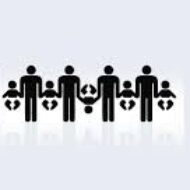Earlier this month, I went snowboarding for the first time in a few years. Not much has changed for me since the last time out. I still suffer from the same heady mix poor depth perception and lousy risk management. I still have a strange talent for collapsing in a heap at the top of the chairlift, where many people get to watch me writhe in the snow as I try to stand up again. And I still find the experience of shooting down a hillside so appealing that I actually don’t mind looking like such a fool.
But there was one major change this time: for the first time in my life, I wore a helmet. And it wasn’t just me. A few years ago, it seemed like skiers and snowboarders came equipped with all kinds of headgear–ear muffs, knit caps, Elmer Fudd hats, headbands, baseball hats. But now it seems like a uniform sea of shiny black skater-shaped safety helmets.
The National Ski Areas Association (NSAA) backs up that impression: they report that last season, 57% of skiers and snowboarders wore helmets, an increase of 19% from the year before. Eight years ago, only a quarter of skiers and snowboarders wore them.
In the majority of circumstances, of course, having a helmet makes a big difference–especially in the kind of glancing blows and freak accidents that can cause unexpected brain trauma–so it’s hard to argue against wearing them. There’s a reason that California’s legislature, always on the cutting edge of nanny-state innovations, considered passing a bill last spring that would make helmets mandatory at in-state ski resorts (they backed off eventually).
But there is a counterargument to be made, particularly when it comes to fatalities. As the NSAA points out, fatality rates have remained stubbornly constant over the past three decades of better awareness and equipment, even as other types of injuries have fallen dramatically (it’s worth pointing out that skiing and boarding is still very safe, much more so than driving, for example).
There’s a certain profile to the average person who dies on the slopes: he (and it’s usually a he) is in his mid-twenties to forties, is an intermediate to advanced skier or boarder, and is hugely overconfident, going faster than he should. In other words, he’s a lot like me.
Which gets us back to my helmet. If anything, I felt more indestructible once I had it on. I’m not sure I even knew that helmets are only rated for impacts at 12 mph or less. Nor I did I think much about the fact that as rates of helmet usage go up, so do the number of people who die wearing their helmets. Helmets do little for the kind of high-speed, low-control accidents that actually kill people.
So why did I wear mine? For the same reason I started regularly wearing a bike helmet for the first time this summer: my four-year-old daughter makes me. Not in an overt way, perhaps, but simply by exposing my hypocrisies, the way young children do. We started putting helmets and knee pads on her when she rode her scooter and then her bike (the knee pads were overkill, I eventually decided). So when it came time for me to go biking with her, she wanted to know if I was going to wear a helmet. I actually contemplated coming up with some lie about adults having harder skulls or somesuch, but fortunately decided it was easier to just do the right thing.
This month’s snow trip was the first time my daughter went skiing for real, chair lifts (she didn’t fall at the top!) and everything. And part of her kit–part of every child’s kit on the mountain–is a miniature black helmet. Throughout the industry, in fact, it has been child safety that has opened the door to adults wearing helmets. Helmets really are mandatory in a lot of kids ski schools. Vail also makes its instructors and employees ski or board with them to set examples for the children. The NSAA has their own campaign called Lids on Kids to drive home the message. And they’re right: focus on the kids first, and even reluctant parents (like me) will follow. I actually liked the helmet. It’s warm, and when used right, it will keep me safe. I don’t think I’ll board without one in the future.
There’s no shortage of irony there, of course. I’m constantly aping the Yo Gabba Gabba “try it, you’ll like it” mantra to my kids. And they’re constantly being irrational about their decisions—saying they just don’t feel like eating this, or buckling that, only to find that it’s actually no problem at all. I have complained about this behavior richly to my friends and on my blog. But it turns out they just learned it from me.

I started wearing a helmet while skiing and snowboarding about 15 years ago. Nowadays I would feel very vulnerable without one. But it took me a good ten years to convince my parents, who, in their mid-seventies, put in about 100 days a year at Mt. Bachelor, to wear them. I don’t know what’s going on with parents these days.
Beta Dad: There’s a Mt. Bachelor? –Theodore.